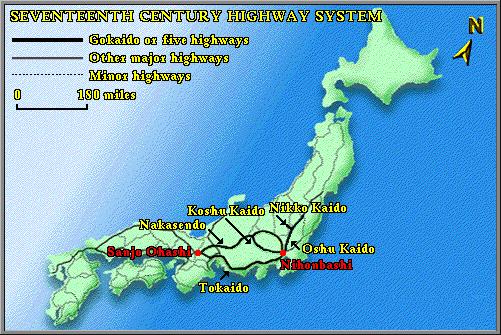There are five highways (“gokaido”) in Japan which were formally established during the Edo period as the official routes which the daimyo should follow on sankin kotai processions. All of them terminated at Nihonbashi in the center of Edo. They are the:

17th century Highway System
* Tokaido, which runs from Kyoto to Edo following the Pacific coast and coastal plains;
* Nakasendo, which runs from Kyoto to Edo through the central mountains;
* Koshu-kaido, which runs from Shimo-suwa to Edo on a more southerly route from the Nakasendo;
* Nikko-kaido, which runs from Edo north and east to the mountain town of Nikko; and
* Oshu-kaido, which runs together with the Nikko-kaido until reaching Utsunomiya where the Nikko road turns off and the Oshu-kaido continues on north to Shirakawa and unofficially to Sendai.
The five roads served to speed the passage of personnel and dispatch boxes which were crucial to the shogunate’s attempts to stabilize and rule the country. Barriers were built to inspect and control traffic and post-towns were established to provide accommodation as well as transport facilities. The roads made possible the system of alternate residence which was an important form of central control over the daimyo. Over time, the five roads were also used heavily by unofficial travelers and commercial interests. The roads, then, served to increase the government’s control over the nation and also to stimulate the growth of a market economy of national proportions. Although the Tokugawa shogunate controlled a decentralized feudal system, the five roads served over the Edo period’s two and a half centuries to created an integrated, centralized nation.
The Tokaido was the most important highway because practically all of the official traffic and daimyo were directed to travel on it. The Tokaido’s post-towns generally had 50 to 200 inns and 100 horses and porters. The Nakasendo was the second most important highway and had a lighter load of traffic and daimyo. Its post-towns usually had around 20 to 30 inns and maintained 25 horses and porters to service official travel.

The five roads were directly controlled by the shogunate which appointed direct retainers to ensure that the road system functioned properly and that the roads and towns were adequately maintained. A visit by road officials was a period of great stress for a village; it usually implied that there was a problem and that someone or the whole village would suffer as a result of the investigation.

17th century Highway System

